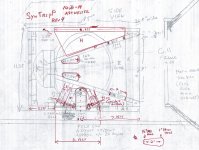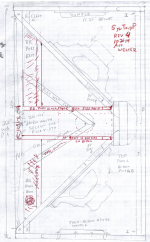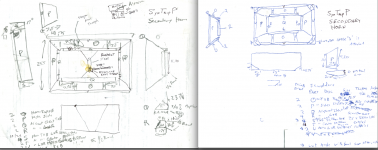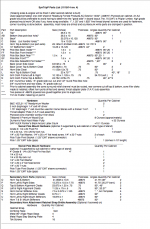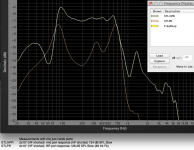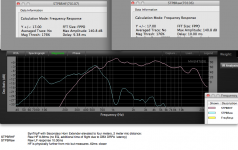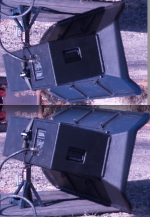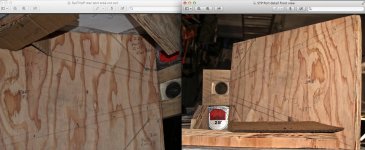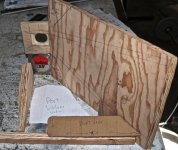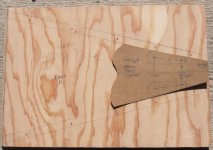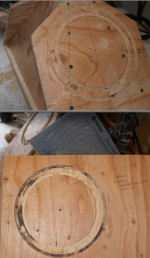Erin,I'm currently in the "thought" phase (ie; ADD making me review all possible alternatives and yet prohibiting me from doing anything fully) of my home theater 'baffle wall' for LCR options...Up until last night, I was pretty set on a BMS 12" coaxial design for simplicity.
WOW!
The amount of documentation you've provided is stellar.
So, I have to ask... is this something you would mind sharing dimension/geometry details so we can *ahem* copy your work?
Practically every single one of your requirements for your build are perfectly in line with mine. Ideally, I'd like to keep a $400 budget and achieve high efficiency and output down to 100hz where subwoofers would then take over. And like you, I LOVE DIY but after years of this stuff, I have reached the point where I'm okay using existing designs that have the technical data to prove their merit.
So, to summarize...
Your efforts are astounding.
The results look awe-some.
Where's the tip jar?
Do you have BOM/schematics for us to clone your design?
- Erin
Your ideal of high efficiency with output down to 100 Hz (the SynTripP as built has a F3 of 82 Hz, around the same frequency of the low "E" note on a guitar) and a budget of $400 are at odds, unless that refers to the budget for just one, which would require a cheaper HF driver.
As the Grateful Dead song says "What a long, strange Trip it's been". After growing up in the 1960's to the sound of Karlsons cabinets with 8" whizzer cone (primitive co-ax, Freddiy purchased them a few years ago, unfortunately one was dropped in transit and broke the magnet assembly off) built by my father scaled down from plans in Popular Mechanics. In 1972 built a 15" Karlson, around 1996 built some great sounding cabinets for my sailboat using Seas P17 coax with Vifa bass assist drivers. The 1992 Maltese nested horns were my first attempt at large scale integration of the single point source concept. Though I have long known a single point source was the ideal solution for all my sound requirements, their rigging requirements generally preclude their use other than for very large venues. To get around that problem have been using a ground stacked line array as a portable solution for the size audiences they cover, up to around 5000 persons.
After reviewing all the possible single point source alternatives since around 1972, and the "semi single point source" a line array provides, I can honestly say the difference in sound between a 12" or 15" coaxial design and the pattern control coupled with the tilt-able stand mount the SynTripP offers is like comparing a shotgun to a rifle, the coax scatters the "shot" (sound waves) all over the room, the SynTripP perfectly hits the "target" (the desired listening positions) and doesn't cover the rest with "ricochet shot" (unwanted reflections).
The SynTripP has not yet completely achieved all my objectives, before I completed the plans there were seven steps I wanted to accomplish on the "critical path", defined in Buckminister Fuller's 1981 book of the same name (the precursor to his amazing "Synergetics, Explorations in the Geometry of Thinking"):
"A critical path develops an exhaustive list of all that has to be accomplished in order to arrive successfully at a given objective is theretofour never reached."
Critical path steps must be followed in order, there were around two million tasks in the Apollo program to put man on the moon, initially proposed May 25, 1961, accomplished on July 20, 1969. A million of those tasks had never before been done by humans before .
Doing the step of putting the plans out before all the steps were completed will result in extra work to do later, probably adding another few days before the critical path is complete. To finish the plans with exact measurements requires assembly of the second SynTripP. A close estimate of the build time required will be posted after completion of the second cabinet. The updates to the plans have taken more than 9 hours today, over twice the time I had allotted to accomplish additional outdoor testing. Hope it does not snow tomorrow.
The prototype nature of the first SynTripP required several iterations of the design, some requiring difficulties just like "building a boat in a bottle". This has resulted in minor design changes that will greatly speed the process of assembly of the second and any subsequent SynTripP builds.
In reference to your question "Where's the tip jar?", it will be in my Pay Pal account, or other suitable alternatives, some trades may be considered also ;^). After having designed dozens of cabinets, and built hundreds, found the SynTripP more challenging to build than any other than the Maltese Horn. Even after lofting (drawing) the plans full size on the actual plywood used, a necessary step on the critical path, still made several construction errors costing many hours to correct, due to doing sub-assemblies in the wrong order. Those steps and photos presently are in shorthand, after showing some of them to "xrk971", his reply was "That BR port is pretty complicated. I think I will leave it alone, I can't even visualize how it looks."
I don't mind sharing the dimension/geometry details of the SynTripP, but to write up the assembly plans accompanied by dozens of photos taken of the sub assembly operations performed in the necessary order needed for a competent woodworker with a rather extensive set of tools to correctly assemble the SynTripP in the minimum amount of time would take far more time than I'm willing to "give away" on top of the hundreds of hours already spent. The basic plans and parts list as presented already took over 20 hours work , but as there are some fairly major differences between Rev 3 and Rev 4 wanted to post them lest people build something that would not perform like the SynTriP does as built.
If an individual, or group of individuals wish to provide funding, I'd consider writing up the detailed plans and build sequence with templates, and provide phone support for anyone considering, or undertaking a SynTripP build. I'd also be available for consultation on the use of alternative drivers in the SynTripP. Regardless of funding, I will be posting the few missing dimensions on the parts list after the second cabinet assembly is finished.
There are six of the 1.4" aluminum/Baltic Birch throat assembly parts (difficult to make with typical woodworking tools) available for sale in the "roughed in" state.
Art
Attachments
Last edited:
Agreed. From my incomplete (so far) experience with Synergy horns, they are the best I've heard too, for the reasons that have been mentioned here.
Did you get the Trynergy working with woofers and EQ and XO yet?
There is something very special about the sound from a synergy - the directionally of the horn reduces reflections from the room and increases the signal to noise ratio. Noise being reflected sound. To have then coherency of the point source and the super high sensititivity (reduces distortion as you play with less cone movement), it all comes together with effortless dynamics. I have not heard an open face driver speaker that is as good. I have not heard KEF's but the synergy is definitely the best speaker I have heard.
I totally agree; it's the reasons I rate the Synergies higher than the Kefs, and the reason I like the 5" B&C more than the 8" B&C. Basically there's something really magical that happens when you get the midrange and the tweeter radiating from a point in space that's the size of a tennis ball.

His current speakers are pretty sweet though.
One thing that I like about the Kefs is that they don't have that "giant headphone" effect. Their radiation is much wider, and due to that, you get more reflections off of the room. Some people will find those additional reflections distracting, but some will like the additional ambience that they add.
If I had the space, I'd have Kefs in one room and Synergies in the other
0001 ND4015BE - HF Drivers - Neodymium ND4015BE : Eighteen Sound - professional loudspeakers
I hope someone with deep pockets can make this happen. Would be fantastic in this design.
I hope someone with deep pockets can make this happen. Would be fantastic in this design.
Hi Art
Wjy not invite Mr Danley himself to optimize the design including passive crossover and licensing the patent and make this is an authorized/legal product for diy? You can sell finished product, flat pack or plans only. I remember Mr Danley said will do something for diy but not realized until now.
Wjy not invite Mr Danley himself to optimize the design including passive crossover and licensing the patent and make this is an authorized/legal product for diy? You can sell finished product, flat pack or plans only. I remember Mr Danley said will do something for diy but not realized until now.
Panjilaras,Hi Art
Wjy not invite Mr Danley himself to optimize the design including passive crossover and licensing the patent and make this is an authorized/legal product for diy? You can sell finished product, flat pack or plans only.
I have no desire to sell flat packs or finished product, I'm still nursing my swollen left wrist after finishing just one cabinet
The SynTripP design, other than final DSP choices and development of a passive crossover design, is already optimized for my personal and professional use. Any person wishing to duplicate my designs for their own use is welcome to, any person or corporate entity that would like to produce them for sale may contact me to negotiate a licensing deal, or purchase exclusive rights to produce the SynTripP™, SynTripP3D™ and various companion sub designs I previously have made available such as the Keystone Sub™.
The design approach for a passive crossover depends on the desired usage. I will be designing a passive crossover for my intended sound reinforcement use with outboard equalization, so it will use little, if any (power wasting, cabinet heating) attenuation. The combined response of the SynTripP LF and HF with no crossover whatsoever is quite good, so a passive crossover with the attenuation and filters required for flat response could be designed without great difficulty, but frequency response is dependent on room (boundary) placement, so there is no "one size fits all" passive crossover. Development of passive crossovers for even the many typical uses:
1) Large venue or outdoor use well away from boundaries (free space).
2) Head level, some distance from rear wall ("semi" free space).
3) Head level, cabinet positioned on rear wall (pseudo half space).
4) Head level, corner ("semi" 1/4 space).
5) Ceiling or floor positioned, angled down or up to the preferred listening position ("semi" 1/4 space, tending towards 1/8th space).
6) Ceiling or floor corner positioned, angled down or up to the preferred listening position(1/8 space).
Since the SynTripP can be used with or without the secondary horn, and with five different tunings ("normal" with four ports open, or "step down" with 1-3 BR ports covered, or sealed) something like 60 different crossover designs would be needed to cover all the possible response differences, design work I won't be doing (unless paid) since EQ can be applied in a matter of seconds to adjust for any of the tuning choices, boundary conditions, or personal "house curve" preferences.
The SynTripP has an F3 of 82 Hz, so typically would be used with one or more subwoofers, though in "step down" mode with one or more ports covered the response is adequate to reproduce instruments such as an upright bass at "live" sound levels. Subwoofers are most easily (if not cost effectively) crossed over and time aligned with DSP which typically incorporates equalization, so passive EQ design is not high on my priority list, and will be designed for my primary use in free space.
Art
Welter Systems Inc.
@ weltersys
An F3 of 82 Hz is excellent, but how is that achieved with such a short path length ?
Also, what are the 1st etc port resonance frequencies, & how have you tamed them ?
Is the 0.4mS HF delay to better integrate the drivers @ the Xover point, due to them having different characteristics etc ?
An F3 of 82 Hz is excellent, but how is that achieved with such a short path length ?
Also, what are the 1st etc port resonance frequencies, & how have you tamed them ?
Is the 0.4mS HF delay to better integrate the drivers @ the Xover point, due to them having different characteristics etc ?
Weltersys can answer with specifics but bass reflex assist (re-injected into horn near mouth opening) is used to go below 100Hz. The port resonances (circa 1kHz) of the main bass injection ports are above the XO point (circa 800Hz) by careful design of port area, location, and driver chamber volume, through models and simulation in AkAbak and lots of testing. See development thread for details. The bass reflex ports if not carefully done (too long for example) can contribute a negative port cancellation peak around 600Hz that can be avoided by keeping port length shorter.
Last edited:
Zero,@ weltersys
1)An F3 of 82 Hz is excellent, but how is that achieved with such a short path length ?
2) Also, what are the 1st etc port resonance frequencies, & how have you tamed them ?
3) Is the 0.4mS HF delay to better integrate the drivers @ the Xover point, due to them having different characteristics etc ?
1) With the large secondary expansion, the SynTripP horn has a DI (Directivity Index) in the range of 11.25, it loads down to around 100Hz. The BR (bass reflex) ports add 3-5 dB gain in the Fb (box tuning) region, and also reduce excursion considerably compared to sealed. Clean LF output capability ported is around 10 dB (about twice as loud) more than sealed. "Normal" operation with the 4 BR ports open results in an F3 of 82 Hz, in "step down" mode with 1-3 BR ports covered, or all four ports covered (sealed) results in 5 different responses which can be seen in the chart labeled "SynTripP LF Raw +0=98.6 dB" in the OP.
2) The rather unusual port design "tamed" the port resonances, their response can be seen in the chart below. The upper BR resonance peak is at 700 Hz, when the mic is moved out from the BR port cavity, the peak reduces compared to the Fb BR peak so much compared to the horn output it's effects are quite minimal (under 1 dB) on the response.
3) The .4 ms delay is used to compensate for the "time of flight" difference between LF output and HF. Though the HF driver is physically further from the measurement mic, it's output arrives .62ms before the BP (band pass) LF output. The .22 ms delay difference between .62 and .4 result from the analog style EQ and crossover filters used, and the underlap (800 Hz BW24 LF, 950 Hz LR24 HF) in the electrical crossover required to achieve the desired acoustical crossover.
Art
Attachments
@ xrk971
So it's the re-inject trick that helps it achieve that. Some time ago on here i posted a pic i drew of doing that, & wondered what the result might be. I don't "think" i got a very positive answer, @ the time ! It wasn't on a horn though.
@ weltersys
1 - I understand about tuning boxes, having done it many times over the years. It's the shorter path length, compared to a "typical" horn, which achieves that f3 that intrigued me.
2 - OK
3 - As i thought, & what TD "sort of" mentioned in other threads, about his xovers/alignments.
All the best with your continued nice designs & builds, & Thanx to both of you
(re-injected into horn near mouth opening) is used to go below 100Hz.
So it's the re-inject trick that helps it achieve that. Some time ago on here i posted a pic i drew of doing that, & wondered what the result might be. I don't "think" i got a very positive answer, @ the time ! It wasn't on a horn though.
@ weltersys
1 - I understand about tuning boxes, having done it many times over the years. It's the shorter path length, compared to a "typical" horn, which achieves that f3 that intrigued me.
2 - OK
3 - As i thought, & what TD "sort of" mentioned in other threads, about his xovers/alignments.
All the best with your continued nice designs & builds, & Thanx to both of you
Interesting cabinet, I'm familiar with the low distortion of well designed horn loaded(Line array?) tops(BFM DR280) and would love to hear this design and brings to the table compared to it.
Two questions:
1. I'm curious what made you choose the 82 hz f3 point, in my world(modern electronic music) it's too high to be able to use without subs, but a bit low to meet with subs(mostly designed to play well up to 100 hz), couldn't it be optimized above 100 hz and achieve slightly higher sensitivity?
2. If I would need moar SPL, how are these things supposed to be stacked? Every picture I've seen of DSL synergys, they have been single stacked at each side of the stage, but they are quite a bit larger than this cab and will probably pound out quite a bit more of SPL, so stacking synergys is a mystery for me.
Thank you for an interesting project to follow!
Two questions:
1. I'm curious what made you choose the 82 hz f3 point, in my world(modern electronic music) it's too high to be able to use without subs, but a bit low to meet with subs(mostly designed to play well up to 100 hz), couldn't it be optimized above 100 hz and achieve slightly higher sensitivity?
2. If I would need moar SPL, how are these things supposed to be stacked? Every picture I've seen of DSL synergys, they have been single stacked at each side of the stage, but they are quite a bit larger than this cab and will probably pound out quite a bit more of SPL, so stacking synergys is a mystery for me.
Thank you for an interesting project to follow!
Last edited:
1) In the world of real instruments, 82 Hz is the low E on a 6 string guitar, the SynTripP can reproduce the fundamental note. An upright bass' low E is 41 Hz, the second harmonic (usually louder than the fundamental) is 82 Hz. The cabinet can be used without subs for many types of music. Raising the Fb to 100 Hz would increase sensitivity, but would put the excursion maximum just above 100 Hz, with the Fb at 86 Hz, crossing at 100Hz full power can be applied without exceeding Xmax.1. I'm curious what made you choose the 82 hz f3 point, in my world(modern electronic music) it's too high to be able to use without subs, but a bit low to meet with subs(mostly designed to play well up to 100 hz), couldn't it be optimized above 100 hz and achieve slightly higher sensitivity?
2. If I would need moar SPL, how are these things supposed to be stacked?
Every picture I've seen of DSL synergys, they have been single stacked at each side of the stage, but they are quite a bit larger than this cab and will probably pound out quite a bit more of SPL, so stacking synergys is a mystery for me.
Tapped horn subs generally have only a two octave smooth range, being able to cross at 82 Hz allows a TH with a 20-80 Hz range to be used, nice for deep electronica, dubstep, pipe organs, etc.
2) DSL makes a wide range of designs, many are larger with more output, many are smaller, with less output than the SynTripP.
Ideally, to avoid comb filtering, one does not want HF coverage overlap, as there will be peaks and dips in the response, as can be seen in the BFM DR280 using multiple cross firing piezo horns.
The SynTripP is 90x40 (technically 86 x 46) degree horn, so depending on the desired coverage area, multiples would be splayed side by side or vertically, with the angle between cabinets around 18 degrees. Prop boxes could be made to fit those applications.
The SynTripP was designed to provide even SPL coverage at typical venues with SPL not exceeding OSHA permissible levels. If you need more level than it provides, either the larger DSL Synergies/Jericho would be more appropriate, or line array cabinets with narrow vertical HF dispersion in the 5 to 10 degree range.
Art
Attachments
Hi Kaygey
See Post #1
"...just under 34 pounds (15.5 kilos) for the...main cabinet which also incorporates an adjustable tilting stand mount adjustable over a 40 degree range"
"The pyramid shaped second section of the horn is detachable... weighing about 5 pounds (2 kilos)."
Cheers
See Post #1
"...just under 34 pounds (15.5 kilos) for the...main cabinet which also incorporates an adjustable tilting stand mount adjustable over a 40 degree range"
"The pyramid shaped second section of the horn is detachable... weighing about 5 pounds (2 kilos)."
Cheers
Art,
Just discovered this (and the original) thread. Wow, this looks like a fantastic design.
I’ve been looking for a mid-bass horn that would cover 100-800Hz and: whala! Plus the coincident design of HF horn. It’s a miracle!
I’m sure you are very busy with this and other things, but by any chance have you sketched out the location of the B.P and B.R ports yet? Would complete the LF design?
Thanks
Bob
Just discovered this (and the original) thread. Wow, this looks like a fantastic design.
I’ve been looking for a mid-bass horn that would cover 100-800Hz and: whala! Plus the coincident design of HF horn. It’s a miracle!
I’m sure you are very busy with this and other things, but by any chance have you sketched out the location of the B.P and B.R ports yet? Would complete the LF design?
Thanks
Bob
Bob,
Domestic life has thus far precluded a detailed "build guide", but the plans in post #41 are near complete, the change in the port from the original is in red ink.
The pictures below give sizes of the BP and BR port entrance and exits.
Cheers,
Art
Domestic life has thus far precluded a detailed "build guide", but the plans in post #41 are near complete, the change in the port from the original is in red ink.
The pictures below give sizes of the BP and BR port entrance and exits.
Cheers,
Art
Attachments
Last edited:
- Home
- Loudspeakers
- Multi-Way
- SynTripP: 2-way 2-part Virtual Single Point Source Horn
